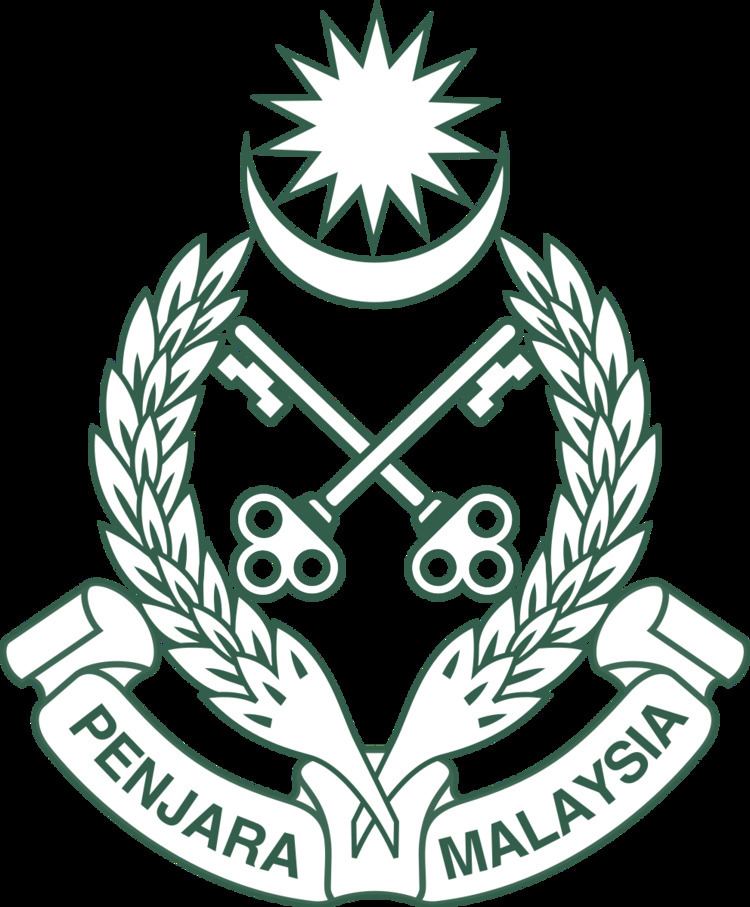Formed 1879 Population 27,544,000 | Legal jurisdiction National | |
 | ||
Legal personality Governmental: Government agency Size 329,847 km (127,355 sq mi) | ||
The Malaysian Prison Department (Malay: Jabatan Penjara Malaysia) is a department controlled by the Malaysian Ministry of Internal Security responsible for jails where offenders sentenced by the courts are held. These jails also act as detention and recovery institutions.
Contents
- Prison history
- History of Malaysian prisons
- Insignia
- Motto
- Commissioner Generals since 1946
- Institutions
- Weaponry and equipment
- References
The department is headquartered in the Malaysia Prison Complex (Kompleks Penjara Kajang) in Kajang, Selangor in the Klang Valley.
Prison history
Prisons are different from other institutions or organisations found in a modern society. They are places where a group of trained personnel manages and looks after a group of people known as prisoners who are not there voluntarily and are instead forced inside and prevented from leaving by guards, walls and gates. A Prison Department cannot choose its clients and they have no power to release them. These prisoners have to live according to set of prescribed rules, and their movements are tightly controlled.
History of Malaysian prisons
During the era of British rule and until the arrival of the Japanese in 1942, penal institutions were the responsibility of the individual states' governments with their respective regulations. In the Straits Settlements, a Superintendent based in Singapore, acted as the supervisor and inspected the institutions under his jurisdiction.
The Straits Settlements were the earliest to build their own prisons while the Federated Malay States did so only after the British set up a responsible department. The Taiping Prison, better known as the Taiping Gaol, the largest at the time, was built in 1879. Prisons were built with the main purpose of bringing suffering to the inmates in the hope that this would deter people from committing crimes.
In 1881, Sikh warders were brought in to assist Malay warders while vocational instructors from Hong Kong were used in an effort to introduce trades to the prisons. Among the earliest of these were rock breaking and carpentry. An attempt was made to categorise the inmates in 1882, then in 1889 European warders were appointed at some prisons.
With the formation of the Federated Malay States, Taiping Prison became a detention centre for long-term prisoners from Perak, Pahang, Negeri Sembilan and Selangor. In 1923, a visiting justice system was introduced and prison industries expanded to include printing work, weaving, sewing, rattan weaving, and metalwork. Rock-breaking work was abolished in 1924 and replaced with the pounding of coconut husks.
During the Japanese occupation (1941–1945), the Imperial Japanese Army also used the prisons for POWs. All records of the prisons and its inmates for this period were subsequently destroyed by the Japanese.
After World War II, the Prison Office was established to administer all prisons in Malaya. The post-war era saw the return of peace, and modern administrative methods were introduced. The 1948 Malayan Emergency resulted in an increase in inmate numbers, which in turn caused overcrowding in the prisons. This disrupted the development of the prison system and it was only towards the end of 1949 when peace returned that prison development could be carried out smoothly.
The Prisons Ordinance 1952 and the Prisons Regulations 1953, based on the "modern treatment" concept, were introduced to replace old legislation. In 1953, the Criminal Justice Bill was passed, which abolished use of the cat-o'-nine-tails and replaced the term "penal servitude" with "prison".
Following Independence Day in 1957, the first Prisons Commissioner was appointed to take charge of the administration of all prisons in Malaya. In 1963, with the formation of Malaysia, prisons in Sabah and Sarawak came under the jurisdiction of the Prisons Department.
On 2 November 1995, the Prison Act 1995 was introduced to replace the former Prison Act which in turn was superseded on 1 September 2000 by the Prison Regulations 2000. The previous acts and regulations had been in use for a long time, thus changes and reforms were necessary to meet current needs and demands to streamline prison management and administration.
In an era of development and modernisation, the Malaysian Prison Department realises that it should not to be content with is past achievements, but should instead move forward and innovate in order to assist the prison administration in dealing with modern culture through criminology, penology and overall social control.
Insignia
- The fourteen-point star represents the 13 States and the Federal Government of Malaysia, while the star and the crescent symbolise Islam, the official religion of Malaysia.
- The crossed keys symbolise the authority and responsibility delegated by the department in the performance of its duties.
- The paddy flower symbolises solidarity and close co-operation by multiracial staff at various levels in the hierarchy.
- The green background, the official colour of the Prisons Department, signifies allegiance to the Malaysian leader.
Motto
Source:
Symbolises the sincerity of the departments management system in generating commitment and co-operation among society at large, offender families and the department to ensure the success of rehabilitation programmes.
Commissioner-Generals since 1946
- Captain Es Lilley (1946-04-01 - 1949-09-11)
- Captain Ov Garrat (1949-09-11 - 1956-10-01)
- Ft. Lt. WB Oliver (1956-10-01 - 1957-10-02)
- Tan Sri Murad Ahmad (1957-10-03 - 1977-07-24)
- Dato' Ibrahim Hj. Mohamed (1977-07-25 - 1988-04-30)
- Dato' Hj. Nik Ariffin Hj. Nik Omar (1988-05-01 - 1989-11-07)
- Dato' Mohd. Yassin Hj. Jaafar (1990-03-01 - 1994-02-07)
- Dato' Mohd Zaman Khan (1994-02-09 - 1997-12-31)
- Dato' Omar Mohamed Dan (1998-01-01 - 2001-10-16)
- Datuk Mustafa Osman (2001-10-17 - 2009-06-01)
- Datuk Seri Zulkifli Omar (2009-06-01 - present)
Institutions
Weaponry and equipment
Malaysian Prison Department operators are equipped with multi-specialized weaponry and marine assault vehicles, including:
